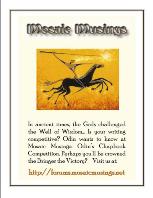 Apr 25 10, 04:00 Apr 25 10, 04:00
Post
#1
|
|
|
Group: Gold Member Posts: 273 Joined: 21-July 07 From: somewhere twixt 'n' tween Member No.: 456 Real Name: Sam Richmond Writer of: Poetry & Prose Referred By:N/A |
New poetry form ???
Pentesam~Any number of five line stanzas in iambic pentameter, rhyme pattern ababb. Example: (First one ever). Improperly Pok't
Woulds't poking come more noble in the dark Where not a prying eye is wont to see Or pok't in darkness might he miss the mark And leave thee with abrasions on thy knee Time spent, methinks, in practice is the key ·······  ······· ······· Values are to integrity as spirit to spirituality ... the one is needed that the other is sustained ~ Sam
MM Award Winner    |
|
|
|
 |
Replies
 Feb 20 11, 16:12 Feb 20 11, 16:12
Post
#2
|
|
|
Group: Gold Member Posts: 11,825 Joined: 15-June 07 From: Springfield, Louisiana Member No.: 446 Real Name: Larry D. Jennings Writer of: Poetry & Prose Referred By:Just wondered in. |
Hi Sam,
Having acquiesced to the fact that your "Pentasam" is unique in a number of ways and not wishing to be argumentative, I thought I would include a few facts about Cinquains and their offshoots or perhaps the roots of the Cinquain itself. Traditional Cinquains are based on syllables. line 1 - 2 syllables line 2 - 4 syllables line 3 - 6 syllables line 4 - 8 syllables line 5 - 2 syllables Modern Cinquains are based on word count in conjunction with words of a certain types. line 1 - one word, usually a noun used as a title or name of the subject about which the poem is written line 2 - two words, usually adjectives which describe the title line 3 - three words, usually verbs which describe an action relating to the title line 4 - four words describing a feeling about the title, usually in the form of a complete sentence line 5 - one word referring back to the title Most of the time in both types of Cinquains, there is no end-rhyme and thus, could be construed to be more prosaic in form. I don't know where Tinker obtained information about the origination of this form but the American Cinquain was, in fact, invented in the late 1800's to a little before or around 1915 by Adelaide Crapsey and was inspired by the Japanese Haiku and Tanka forms. Other "five-line" poems such as the Sicilian quintain, the English quintain, the Spanish quintella, the Japanese tanka, and the French cinquain all predate her americanization of this form. With the Sicilian quintain, the original form had no set form or meter, but later it was formalized using IP with the rhyme scheme of a b a b a. Not like the "Pentasam" which is ababb... The French cinquain is most probably a foreshortened version of the French Ballade consisting of three Stanza of eight lines each with the rhyme scheme of ababbcbC, with recurrent "last-lines" in each successive stanza and which was then followed by a four line envoy with a bcbC rhyme scheme. With the English quintain (probably derived from the French cinquain), there is no set measure or foot requirements but has the ababb rhyme scheme of the "Pentasam". Again, some of the parameters are met but not all. The Cinquain is described as unique in its syllable count of each line; 2 4 6 8 2 and is nearly always unrhymed. The original form did not utilize IP (this would have been very difficult with varying syllable counts). Once again, unlike the "Pentasam". As to Browning's "Porphyria's Lover"; this is an English Quintain in Tet - not a Cinquain (see above description of such). Larkin's "Reasons For Attendance" breaks the proported Cinquain (actually another English Quintain) form in the first stanza - (4 lines), (no rhyme scheme - Identicals do not rhyme!), and (extra syls in LL1&3 - not pure IP). Sam, I could go on but I won't. With your set parameters, your "Pentasam" may have similarities to other forms but, like the Cinquain, it is unique and thus, in my opinion a new form. I hope this is where discussion ends and appreciation begins. Larry ·······  ······· ·······When power leads man toward arrogance, poetry reminds him of his limitations. When power narrows the areas of man's concern, poetry reminds him of the richness and diversity of his existence. When power corrupts, poetry cleanses.
John Fitzgerald Kennedy Kindness is a seed sown by the gentlest hand, growing care's flowers. Larry D. Jennings MM Award Winner    |
|
|
|
Posts in this topic
 4rum Pentad~new poetic form? Apr 25 10, 04:00
4rum Pentad~new poetic form? Apr 25 10, 04:00 
 Cleo_Serapis Sam,
What an appealing form! I've not hea... Apr 27 10, 05:32
Cleo_Serapis Sam,
What an appealing form! I've not hea... Apr 27 10, 05:32 
 4rum Hi Lori;
This is one reason I dumped this in Ka... Apr 27 10, 14:54
4rum Hi Lori;
This is one reason I dumped this in Ka... Apr 27 10, 14:54 
 4rum Links to some discussion and definitions of wont. ... Apr 29 10, 03:36
4rum Links to some discussion and definitions of wont. ... Apr 29 10, 03:36 
 Sekhmet Hello Sam - I found this in the Oxford English Dic... Jun 26 10, 08:33
Sekhmet Hello Sam - I found this in the Oxford English Dic... Jun 26 10, 08:33 

 4rum QUOTE (Sekhmet @ Jun 26 10, 09:33 ) Hello... Jun 29 10, 01:00
4rum QUOTE (Sekhmet @ Jun 26 10, 09:33 ) Hello... Jun 29 10, 01:00 
 Larry Hi Sam,
Very droll but to the point...
Just thou... Jun 30 10, 15:15
Larry Hi Sam,
Very droll but to the point...
Just thou... Jun 30 10, 15:15 
 4rum Hi Larry,
Thanks for views. Yeah, I looked at ... Jul 2 10, 12:36
4rum Hi Larry,
Thanks for views. Yeah, I looked at ... Jul 2 10, 12:36 
 AMETHYST Hiya Sam,
Actually this is nothing like a Cinqua... Aug 30 10, 01:31
AMETHYST Hiya Sam,
Actually this is nothing like a Cinqua... Aug 30 10, 01:31 
 Larry Hello Liz,
Been busy and just saw your retort per... Sep 16 10, 13:49
Larry Hello Liz,
Been busy and just saw your retort per... Sep 16 10, 13:49 
 AMETHYST Hi Larry,
Good to see you!!! It... Sep 17 10, 01:16
AMETHYST Hi Larry,
Good to see you!!! It... Sep 17 10, 01:16 
 4rum Dear Liz and Larry;
Wonderful comments from bot... Sep 18 10, 07:36
4rum Dear Liz and Larry;
Wonderful comments from bot... Sep 18 10, 07:36 
 AMETHYST Hey Sam,
Good to see you. Would love to read som... Sep 19 10, 22:25
AMETHYST Hey Sam,
Good to see you. Would love to read som... Sep 19 10, 22:25 
 4rum Liz;
Overjoyed at your enthusaiam and encourage... Sep 21 10, 10:05
4rum Liz;
Overjoyed at your enthusaiam and encourage... Sep 21 10, 10:05 
 Tinker1111 QUOTE (4rum @ Apr 25 10, 02:00 ) New poet... Oct 31 10, 21:12
Tinker1111 QUOTE (4rum @ Apr 25 10, 02:00 ) New poet... Oct 31 10, 21:12 
 4rum Tinker1111;
I'm not nearly the scholar of s... Feb 20 11, 03:24
4rum Tinker1111;
I'm not nearly the scholar of s... Feb 20 11, 03:24 
 JustDaniel Greetings, y'all.
Larry gives a pretty fair s... Feb 22 11, 00:36
JustDaniel Greetings, y'all.
Larry gives a pretty fair s... Feb 22 11, 00:36 
 4rum Thanks Larry for your very detailed introspect int... Feb 22 11, 02:57
4rum Thanks Larry for your very detailed introspect int... Feb 22 11, 02:57 
 JustDaniel Discovery
Each poet writes as best he may
and lea... Feb 22 11, 09:38
JustDaniel Discovery
Each poet writes as best he may
and lea... Feb 22 11, 09:38 1 User(s) are reading this topic (1 Guests and 0 Anonymous Users)
0 Members:
  |

|
Lo-Fi Version | Time is now: 21st October 2025 - 15:47 |



















